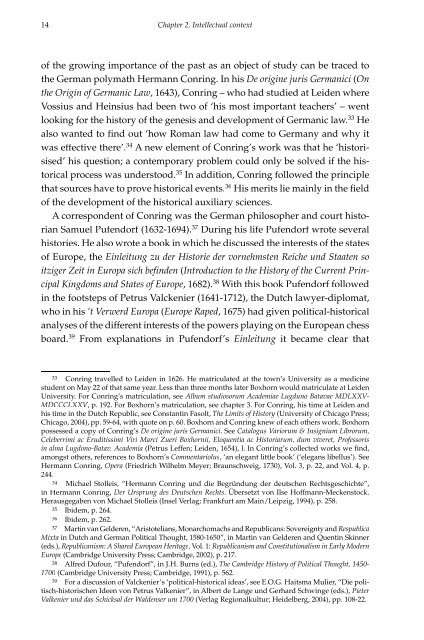historical and political thought in the seventeenth - RePub - Erasmus ...
historical and political thought in the seventeenth - RePub - Erasmus ...
historical and political thought in the seventeenth - RePub - Erasmus ...
You also want an ePaper? Increase the reach of your titles
YUMPU automatically turns print PDFs into web optimized ePapers that Google loves.
14<br />
Chapter 2. Intellectual context<br />
of <strong>the</strong> grow<strong>in</strong>g importance of <strong>the</strong> past as an object of study can be traced to<br />
<strong>the</strong> German polymath Hermann Conr<strong>in</strong>g. In his De orig<strong>in</strong>e juris Germanici (On<br />
<strong>the</strong> Orig<strong>in</strong> of Germanic Law, 1643), Conr<strong>in</strong>g – who had studied at Leiden where<br />
Vossius <strong>and</strong> He<strong>in</strong>sius had been two of ‘his most important teachers’ – went<br />
look<strong>in</strong>g for <strong>the</strong> history of <strong>the</strong> genesis <strong>and</strong> development of Germanic law. 33 He<br />
also wanted to f<strong>in</strong>d out ‘how Roman law had come to Germany <strong>and</strong> why it<br />
was effective <strong>the</strong>re’. 34 A new element of Conr<strong>in</strong>g’s work was that he ‘historisised’<br />
his question; a contemporary problem could only be solved if <strong>the</strong> <strong>historical</strong><br />
process was understood. 35 In addition, Conr<strong>in</strong>g followed <strong>the</strong> pr<strong>in</strong>ciple<br />
that sources have to prove <strong>historical</strong> events. 36 His merits lie ma<strong>in</strong>ly <strong>in</strong> <strong>the</strong> field<br />
of <strong>the</strong> development of <strong>the</strong> <strong>historical</strong> auxiliary sciences.<br />
A correspondent of Conr<strong>in</strong>g was <strong>the</strong> German philosopher <strong>and</strong> court historian<br />
Samuel Pufendorf (1632-1694). 37 Dur<strong>in</strong>g his life Pufendorf wrote several<br />
histories. He also wrote a book <strong>in</strong> which he discussed <strong>the</strong> <strong>in</strong>terests of <strong>the</strong> states<br />
of Europe, <strong>the</strong> E<strong>in</strong>leitung zu der Historie der vornehmsten Reiche und Staaten so<br />
itziger Zeit <strong>in</strong> Europa sich bef<strong>in</strong>den (Introduction to <strong>the</strong> History of <strong>the</strong> Current Pr<strong>in</strong>cipal<br />
K<strong>in</strong>gdoms <strong>and</strong> States of Europe, 1682). 38 With this book Pufendorf followed<br />
<strong>in</strong> <strong>the</strong> footsteps of Petrus Valckenier (1641-1712), <strong>the</strong> Dutch lawyer-diplomat,<br />
who <strong>in</strong> his ‘t Verwerd Europa (Europe Raped, 1675) had given <strong>political</strong>-<strong>historical</strong><br />
analyses of <strong>the</strong> different <strong>in</strong>terests of <strong>the</strong> powers play<strong>in</strong>g on <strong>the</strong> European chess<br />
board. 39 From explanations <strong>in</strong> Pufendorf’s E<strong>in</strong>leitung it became clear that<br />
33 Conr<strong>in</strong>g travelled to Leiden <strong>in</strong> 1626. He matriculated at <strong>the</strong> town’s University as a medic<strong>in</strong>e<br />
student on May 22 of that same year. Less than three months later Boxhorn would matriculate at Leiden<br />
University. For Conr<strong>in</strong>g’s matriculation, see Album studiosorum Academiae Lugduno Batavae MDLXXV-<br />
MDCCCLXXV, MDCCCLXXV p. 192. For Boxhorn’s matriculation, see chapter 3. For Conr<strong>in</strong>g, his time at Leiden <strong>and</strong><br />
his time <strong>in</strong> <strong>the</strong> Dutch Republic, see Constant<strong>in</strong> Fasolt, The Limits of History (University of Chicago Press;<br />
Chicago, 2004), pp. 59-64, with quote on p. 60. Boxhorn <strong>and</strong> Conr<strong>in</strong>g knew of each o<strong>the</strong>rs work. Boxhorn<br />
possessed a copy of Conr<strong>in</strong>g’s De orig<strong>in</strong>e juris Germanici. See Catalogus Variorum & Insignium Librorum,<br />
Celeberrimi ac Eruditissimi Viri Marci Zueri Boxhornii, Eloquentia ac Historiarum, dum viveret, Professoris<br />
<strong>in</strong> alma Lugdono-Batav. Academia (Petrus Leffen; Leiden, 1654), l. In Conr<strong>in</strong>g’s collected works we f<strong>in</strong>d,<br />
amongst o<strong>the</strong>rs, references to Boxhorn’s Commentariolus, ‘an elegant little book’ (‘elegans libellus’). See<br />
Hermann Conr<strong>in</strong>g, Opera (Friedrich Wilhelm Meyer; Braunschweig, 1730), Vol. 3, p. 22, <strong>and</strong> Vol. 4, p.<br />
244.<br />
34 Michael Stolleis, “Hermann Conr<strong>in</strong>g und die Begründung der deutschen Rechtsgeschichte”,<br />
<strong>in</strong> Hermann Conr<strong>in</strong>g, Der Ursprung des Deutschen Rechts. Übersetzt von Ilse Hoffmann-Meckenstock.<br />
Herausgegaben von Michael Stolleis (Insel Verlag; Frankfurt am Ma<strong>in</strong>/Leipzig, 1994), p. 258.<br />
35 Ibidem, p. 264.<br />
36 Ibidem, p. 262.<br />
37 Mart<strong>in</strong> van Gelderen, “Aristotelians, Monarchomachs <strong>and</strong> Republicans: Sovereignty <strong>and</strong> Respublica<br />
Mixta <strong>in</strong> Dutch <strong>and</strong> German Political Thought, 1580-1650”, <strong>in</strong> Mart<strong>in</strong> van Gelderen <strong>and</strong> Quent<strong>in</strong> Sk<strong>in</strong>ner<br />
(eds.), Republicanism: A Shared European Heritage, Vol. 1: Republicanism <strong>and</strong> Constitutionalism <strong>in</strong> Early Modern<br />
Europe (Cambridge University Press; Cambridge, 2002), p. 217.<br />
38 Alfred Dufour, “Pufendorf”, <strong>in</strong> J.H. Burns (ed.), The Cambridge History of Political Thought, 1450-<br />
1700 (Cambridge University Press; Cambridge, 1991), p. 562.<br />
39 For a discussion of Valckenier’s ‘<strong>political</strong>-<strong>historical</strong> ideas’, see E.O.G. Haitsma Mulier, “Die politisch-historischen<br />
Ideen von Petrus Valkenier”, <strong>in</strong> Albert de Lange und Gerhard Schw<strong>in</strong>ge (eds.), Pieter<br />
Valkenier und das Schicksal der Waldenser um 1700 (Verlag Regionalkultur; Heidelberg, 2004), pp. 108-22.

















